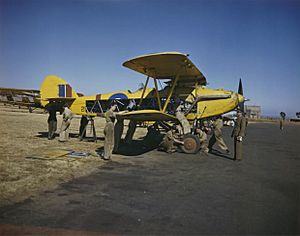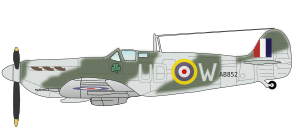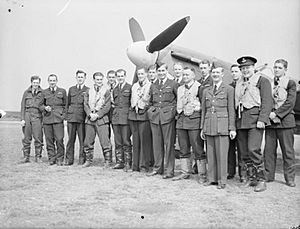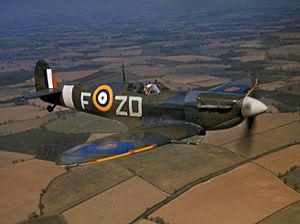Paddy Finucane facts for kids
Quick facts for kids
Brendan "Paddy" Finucane
|
|
|---|---|
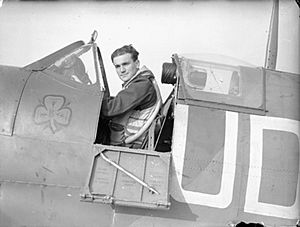
Brendan Finucane in his Spitfire with the shamrock motif on the fuselage.
|
|
| Nickname(s) | Paddy |
| Born | 16 October 1920 Rathmines, County Dublin, Ireland |
| Died | 15 July 1942 (aged 21) English Channel, off Le Touquet, German-occupied France |
| Allegiance | United Kingdom |
| Service/ |
Royal Air Force |
| Years of service | 1938–42 |
| Rank | Wing commander |
| Service number | 41276 |
| Unit | No. 65 Squadron RAF No. 452 Squadron RAAF |
| Commands held | Hornchurch Wing No. 602 Squadron RAF |
| Battles/wars | Second World War
|
| Awards | Distinguished Service Order Distinguished Flying Cross & Two Bars |
Wing Commander Brendan Eamonn Fergus Finucane (born 16 October 1920 – died 15 July 1942) was an Irish Royal Air Force (RAF) fighter pilot during the Second World War. His friends called him Paddy Finucane. He was known as a flying ace, which means he shot down five or more enemy aircraft in air battles.
Brendan grew up in Ireland. In 1936, his family moved to England. There, he became very interested in flying. He joined the RAF in August 1938 to train as a pilot. After some challenges in training, he learned to fly the Supermarine Spitfire. In July 1940, he joined No. 65 Squadron RAF at RAF Hornchurch.
Finucane achieved his first victory on 12 August 1940 during the Battle of Britain. He was credited with shooting down two enemy planes during this time. In April 1941, he was promoted to acting flight lieutenant. He then joined No. 452 Squadron RAAF and flew missions over France. During this period, he was very successful, destroying 20 German aircraft.
In January 1942, Finucane became a squadron leader in No. 602 Squadron RAF. He shot down six more planes, bringing his total to 28. In June 1942, he became the youngest wing commander in RAF history. He was put in charge of the Hornchurch Wing.
On 15 July 1942, Finucane was on a mission over France. His Spitfire was hit by ground fire. He tried to fly back to England across the English Channel. But he had to land his plane in the sea and was never seen again.
Brendan Finucane was officially credited with 28 aerial victories. Some records suggest his total could be as high as 32. He shot down 23 Messerschmitt Bf 109s, four Focke-Wulf Fw 190s, and one Messerschmitt Bf 110.
Contents
Early Life and Dream to Fly
Brendan Finucane was born on 16 October 1920 in Dublin, Ireland. He was the first child of Thomas and Florence Finucane. His mother was English, and his father had been involved in Irish politics before Brendan was born.
When he was young, Brendan and his mother were almost caught in a dangerous fight between police and the Irish Republican Army. Later, his brother Raymond and three sisters were born. Brendan was a good student and loved sports, especially rugby.
In 1932, Brendan and his brother went to an air show. They even had a 10-minute flight! This made Brendan want to become a pilot. He visited more air shows and his dream grew stronger. In 1936, his family moved to Richmond, England. Brendan finished school with good grades. He started an office job as an accountant, but he didn't like it.
In 1937, the RAF started offering short-term pilot jobs. Brendan asked his father if he could join the British Armed Forces. His father agreed, thinking a military career would be good for him.
Joining the Royal Air Force
In April 1938, when he was 17, Finucane applied to the RAF. He was invited for an interview two months later. He showed how eager he was to fly and had good school and sports records. In August 1938, Brendan was told to report for flight training in Northamptonshire.
Within days, Finucane was flying with his instructor in a de Havilland Tiger Moth trainer. He found it hard to control the aircraft at first. He had a few accidents, including a burst tire and a heavy landing that damaged the plane's landing gear. His instructor, Roland Morris, told him to be gentler with the aircraft.
Despite these problems, Finucane wanted to fly alone. He was a bit behind his group in training hours. But on 21 September, he made a successful solo flight. He was still considered an average pilot but good enough for advanced training. In October 1938, he was sent to RAF Montrose in Scotland.
At Montrose, Finucane struggled with the more powerful Hawker Hart planes. His landings were often difficult. But he showed great determination and improved. In June 1939, he was still rated as an average pilot. On 10 July, he crashed a Queen Bee plane in bad weather, but he only cut his thumb. In August, he was officially made a pilot officer.
World War II Begins
Finucane spent the winter of 1939–40 practicing flying. He couldn't get much time in fighter planes. In September 1939, Germany invaded Poland, starting World War II. Finucane's flying skills were not yet good enough for a fighter pilot. He continued training until May 1940.
In May and June 1940, Germany quickly defeated the Netherlands, Belgium, and France. The RAF needed many new pilots because of losses. Finucane's flying had improved. In June 1940, he was sent to learn to fly Supermarine Spitfires. He made 26 flights in a Spitfire in just nine days.
Battle of Britain Hero
On 12 July 1940, Finucane joined No. 65 Squadron RAF at RAF Hornchurch. The Battle of Britain was just starting. His squadron had several experienced aces. Finucane wanted to be as skilled as them. He flew as much as possible to get more experience.
On 25 July, he flew his first mission. His Spitfire had a leak and its radio failed, but he landed safely. On 12 August, he intercepted a German raid. He attacked 30 Messerschmitt Bf 109s and shot one down into the Channel. This was his first confirmed victory. Later that day, his airfield was attacked. Finucane took off and claimed one probable and one damaged Bf 109.
On 13 August, the Luftwaffe launched a huge attack on RAF airfields. Finucane claimed another Bf 109 shot down. On 18 August, he was part of the "Hardest Day" of the battle, when the fighting was most intense. His squadron shot down a German bomber.
On 28 August, his squadron moved to Scotland to rest. On 3 September, Finucane was promoted to flying officer. A report noted he was learning quickly and would become a good leader. Although 65 Squadron stayed in the Battle of Britain until October, Finucane had no more victories during this period.
Fighting Over the Channel
By early 1941, German planes rarely flew during the day. Finucane spent most of his time patrolling the English Channel. On 4 January 1941, he shot down a Bf 110. It took him 15 minutes and four attacks to bring it down.
On 19 January, he and another pilot intercepted a Junkers Ju 88. They chased it close to France, leaving it on fire. It was credited as a shared victory. The German pilot was very skilled, flying low and using the sun to hide.
In early 1941, the RAF began offensive operations over Belgium and France. These "Circus" attacks involved small groups of bombers protected by many fighters. The goal was to draw out the German Luftwaffe.
On 5 February, Finucane shot down another Bf 109 over France. On 14 April 1941, he was promoted to Flight Commander and joined the new Australian No. 452 Squadron RAAF. The next day, 15 April, he shot down another Bf 109. This was his fifth victory, making him an official fighter ace. He was awarded the Distinguished Flying Cross (DFC) on 25 April.
Finucane's start at 452 Squadron was a bit rough. On 3 May, his propeller accidentally hit his new commanding officer's plane during a flight. The officer had to crash-land but survived. Despite this, Finucane was given temporary command of the squadron. He created a relaxed atmosphere, which he believed helped the Australian pilots.
In May 1941, the squadron received new Spitfire Mk. IIs. Finucane chose a plane that had the letter 'W' on its side, as he thought it was lucky. This plane, and others he flew, also had a Shamrock emblem painted on it, which became his personal symbol.
On 11 July 1941, Finucane's squadron flew its first "Circus" mission. Over France, they met German fighters. Finucane shot down a Bf 109, and the pilot bailed out. This was the squadron's first victory.
Leading the Kenley Wing
On 21 July, 452 Squadron moved to Kenley. There, it joined two other squadrons to form the new Kenley Wing. They flew many missions over the summer. Finucane became good friends with Australian pilot Keith Truscott. They often went out in London together. Finucane also met Jean Woolford, who became his fiancée.
On 3 August 1941, the Wing flew another "Circus" operation. Finucane shot down one Bf 109 and probably destroyed another. This brought his total to 7 victories.
On 9 August, Finucane was part of "Circus 68," a large mission involving many RAF wings. Over France, he shot down a Bf 109 and shared two others with Keith Chisholm. The squadron lost three pilots that day.
The squadron then received Spitfire VBs, which had two cannons in each wing. Finucane chose a plane with the lucky 'W' code. On 16 August 1941, he had his most successful day, shooting down three Bf 109s. These were his 9th, 10th, and 11th victories.
On 19 August, Finucane claimed one destroyed and one probable Bf 109. The squadron was doing very well. On 22 August, Finucane was awarded a Bar to his DFC. This meant he received a second DFC medal. The award praised his leadership and fighting spirit. On 27 August, he shot down two more Bf 109s. 452 Squadron was now the most successful in Fighter Command for August.
Finucane went on leave in early September. On 9 September, he was awarded a second Bar to his DFC. On 20 September, he shot down three more Bf 109s, bringing his total to 17.
In Command and Public Fame
Finucane's success and the squadron's achievements brought them fame. The Air Ministry shared their stories with the press. On 21 September 1941, Finucane claimed two more Bf 109s. Newspapers celebrated his victories, calling him a national hero.
On 2 October 1941, Finucane shot down another Bf 109 and damaged two more. When he returned, his Spitfire was painted with his initials and 21 swastika emblems (representing his victories). But Finucane didn't like the decoration and had it removed. On 4 October, he was given temporary command of the squadron. On 11 October, he was awarded the Distinguished Service Order (DSO) for his 21 victories.
On 12 October, Finucane claimed another Bf 109. The next day, he shot down two more Bf 109s. After a night of celebrating, Finucane accidentally broke his heel bone and had to go to the hospital for several weeks. While recovering, he received many messages of congratulations. He even spoke on a BBC radio program from his hospital bed. On 25 November, King George VI personally decorated Finucane at Buckingham Palace.
On 20 January 1942, Finucane was given command of 602 Squadron. Five days later, he was promoted to squadron leader. On 12 February 1942, Finucane's squadron was involved in Operation Cerberus. This was when German warships tried to sail through the English Channel. Finucane's squadron attacked the ships.
On 20 February 1942, Finucane and his wingman, Dick Lewis, flew a mission to France. They encountered two Focke-Wulf Fw 190s, which were more powerful than their Spitfires. Finucane's plane was hit, and he was wounded in the leg. Lewis protected him, and they managed to return home. Finucane spent over a week in the hospital.
Final Missions and Death
Finucane returned to flying on 13 March. He claimed another Fw 190 shot down. He claimed three more successes in the spring of 1942. His unit also started using gun camera footage to help prove their claims.
By late June 1942, Finucane had completed 108 fighter missions over France. On 27 June, he was promoted to wing commander. At 21 years old, he became the youngest wing commander in the RAF. He was put in charge of the Hornchurch Wing. He made some changes to how the wing flew, focusing on tighter discipline and better low-level flying skills.
On 15 July 1942, Finucane was killed during a ground attack mission over France. He took off with his wing to attack a German army camp. As they crossed the French coast, Finucane's plane was hit in the radiator by ground fire. His wingman, Alan Aikman, saw white smoke coming from his plane.
Finucane flew slowly out to sea, gliding his damaged Spitfire. About 8 miles off the coast, he broke radio silence. Aikman saw him open his canopy and say, "This is it, Butch." Finucane tried to land his plane on the water, but the nose hit a wave and the plane disappeared. It's not known exactly what happened, but he was never found.
Memorials
Over 2,500 people attended his memorial service in London. A rose was planted in his memory in Dublin, Ireland, where he first flew. Finucane's name is also on the Air Forces Memorial at Runnymede. This memorial remembers airmen lost in World War II who have no known grave. His name is also on the Battle of Britain Memorial in London.
There are streets and an estate named after him in England. His family donated his uniform to the Royal Air Force Museum London.
Personal Life
Brendan Finucane and his family attended church at Our Lady of Loreto and St Winefride's, Kew, where he was an altar server.
He was engaged to Jean Woolford, who lived near his home in Richmond. She later married another airman in 1944.
Images for kids


